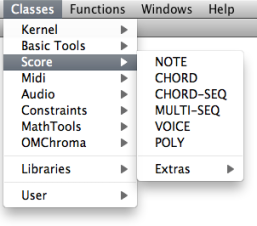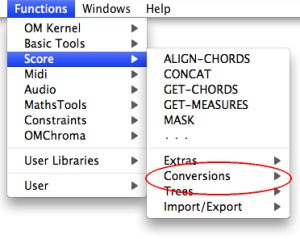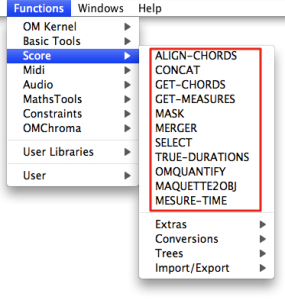| Navigation : Previous | Next |
Score Objects Presentation
Contents
- Types : “Harmonic”, “Rhythmic” and “Polyphonic” Objects.
- Time Representation
- Pitches
- General Score Modules

Score classes enclose the musical objects that compose a score : notes , chords , chord-seqs , voices , polys . Out of convenience, we have gathered these objects in three categories : “harmonic”, “rhythmic” and “polyphonic” objects.
They can be accessed via the Classes / Score menu.

Types : “Harmonic”, “Rhythmic” and “Polyphonic” Objects.
-
Harmonic objects include notes , chords and chord-seqs .
-
Rhythmic objects include voices (internally made of measures and groups).
-
Polyphonic objects include polys and multi-seqs . These are “superimpositions” of objects :
- voices on one hand,
- chord-seqs on the other hand.
Time Representation
These objects can be classified into two temporal categories :
-
** Pulsed, or rhythmic representations ** are based on a traditional rhythmic expression of events in time, via rhythm trees[1]. Voices and polys are pulsed representations.
-
** Linear representations ** are based on the ** absolute duration ** of events - in milliseconds. Chord-seqs and multi-seqs are linear representations.
-
Notes and chords are atomic objects and correspond to both temporal categories.
Expressing Rhythms
Pitches
Pitches in OM are usually represented in midicents.
A midicent is a cent of one MIDI unit, that is, of a half-tone.
MIDI pitch units
In MIDI, the middle C is represented by the value 60, then 61=C#, 62=D, 63=D#, etc.
In midicent, therefore, C=6000, C#=6100, …
Midicents allow to represent microintervals, which standard MIDI values can’t do : 6050 = C+1/4 tone, 6020=C+ 1/10th tone, etc.
How to Play MicroIntervals
Manipulating Pitches in OM : Basic Tools

A set of functions and conversion modules allows to manipulate midicents and pitches in general. They can be accessed via the Functions / Score /menu.
![]()
The frequency-to-midicents function converts frequencies (or lists of frequencies) to midicents.
![]()
The midicents-to-frequencies function converts midicents to frequencies.
Its input takes atoms or lists.
![]()
The name-to-midicents function converts a note name (like “C3”) or a list of note names, to midicent value(s).
![]()
The midicents-to-name function converts a midicents value (or a list of values) to note name(s).
![]()
The approximate-midicents function approximates a midicents value to the closest tempered division of the octave (for isntance 4 = quarter tones).
General Score Modules
A set of score objects manipulation modules are avalable in the Functions / Score menu
References :
- [1] Rhythm Tree
A rhythm tree expresses a rhythmic structure as a list.
This list is made of :
* a duration, or number of measures,
* a list of measures.
Each measure is made of
* a time signature
* a list or proportions, or rhythmic values.
For instance : (1 (((4 4) (1 1 2))) is a rhythm of one measure, signature 4/4, with two quarter and one half note (proportions = 1/4 1/4 2/4 = 1/4 1/4 1/2).
The term of “tree” refers to a recusrive structure: each item in the proportions list can in turn be expressed as a duration with a list of subdivisions.
For instance the second beat in our measure could be subdivided as follows : ((4 4) (1 (1 (2 3)) 2)).
Contents :
- OpenMusic Documentation
- OM User Manual
- OpenMusic QuickStart
| Navigation : Previous | Next |
